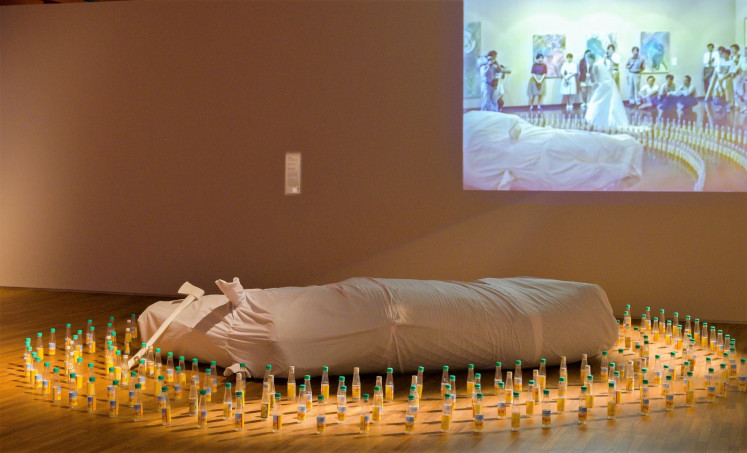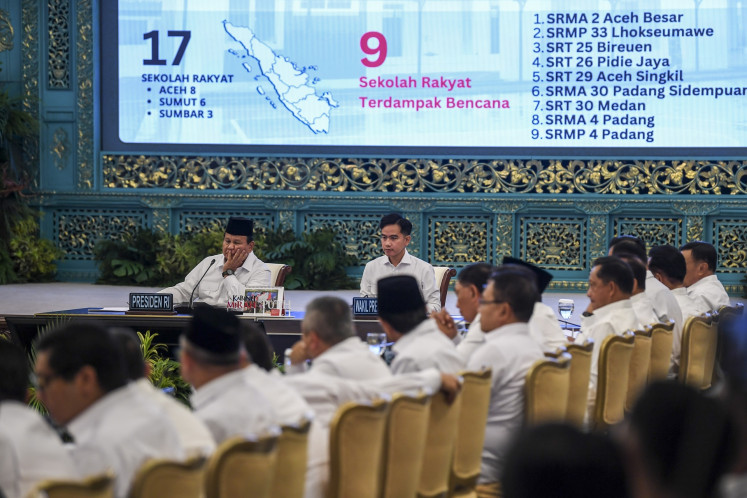Popular Reads
Top Results
Can't find what you're looking for?
View all search resultsPopular Reads
Top Results
Can't find what you're looking for?
View all search results‘Awakenings’ exhibition peeks into Asia’s post-war history
Provocative and at times raw, artworks -- from Yoko Ono's Cut Piece to They Poach the Rhino, Chop Off His Horn and Make This Drink by Singaporean artist Tang Da Wu -- offer an inside look into turbulent times in Asia’s postwar history, marked by ideological confrontations to a wave of democratic movements.
Change text size
Gift Premium Articles
to Anyone
 Art for thought: Huang Yong Ping's 'Reptiles' (left) is one of 142 provocative artworks by more than 100 artists from 12 countries in Asia on display at "Awakenings: Art in Society in Asia 1960s-1990s” exhibition at National Gallery Singapore. The exhibition runs until Sept. 15. (Courtesy of National Gallery Singapore/-)
Art for thought: Huang Yong Ping's 'Reptiles' (left) is one of 142 provocative artworks by more than 100 artists from 12 countries in Asia on display at "Awakenings: Art in Society in Asia 1960s-1990s” exhibition at National Gallery Singapore. The exhibition runs until Sept. 15. (Courtesy of National Gallery Singapore/-)
A
sculpture of a dead rhino without a horn, surrounded by empty drink bottles, offers a clear picture of consumerism’s role in destroying nature.
They Poach the Rhino, Chop Off His Horn and Make This Drink (1989) by Singaporean artist Tang Da Wu brings together installation, performance and ritualistic elements from traditional Chinese culture.
The installation, originally a performance first staged in 1989, sends loud and clear criticism on the Chinese myth about the medicinal properties of the rhinoceros horn that results in poaching and pushing the species into near extinction.
The Rhino is one of the 142 works on display at “Awakenings: Art in Society in Asia 1960s-1990s” exhibition at the National Gallery Singapore. The traveling exhibition, which is in its final stop in Singapore after shows in Japan and South Korea, runs until Sept. 15.
Loud and clear: 'They Poach the Rhino, Chop Off His Horn and Make This Drink' (1989) by Singaporean artist Tang Da Wu showcases how the myth over the medicinal properties of a rhino's horn pushes the species into extinction. (Courtesy of National Gallery Singapore/-)Curator Adele Tan said many artists during the period – a critical turning point in Asia’s postwar history – questioned invisible but dominant structures of power in society and they sought to express the struggles felt by the marginalized with the rise of rapid urbanization and consumer capitalism.
The new awareness also led to the rise of aesthetic experiments and movements to escape the modern concept of “art for art’s sake” while bridging the gap between art and everyday life.
Such aesthetic experiments and movements could be seen through major works on display at the exhibition, including Yoko Ono’s Cut Piece documentation of performance at Carnegie Recital Hall in New York on March 21, 1965, filmed by Albert and David Maysles, being screened at the exhibition.
In the 8-minute and 27-second black-and-white film, the performance of which was conducted a year after its debut in Kyoto, shows Ono sitting alone on stage with scissors in front of her.
The audience was instructed to take turns to approach and cut off a small piece of her clothing. Some did it reluctantly, cutting off a small piece from her sleeve while others boldly cut fabric from the front part of her blouse or even her bra straps. Ono stays still and expressionless.
The audience’s active involvement in art creation was considered revolutionary.
While the film evokes an image of societal oppression against women, it is also seen as a protest against violence when viewed in the context of America’s atomic bombing of Japan during World War II.
Another intriguing installation was Reptiles (1989, remade in 2013) by Huang Yong Ping, who cofounded and led the Xiamen Dada art collective that was among the most radical groups to emerge after the Cultural Revolution in China.
The work, which explores cultural connections and conflicts between the East and West, was first presented in Paris in May 1989 as part of the ground-breaking show “Magicians of the World”, now considered the first major exhibition addressing the globalization of the art world. The artist himself remained in Paris after the show.
National Gallery Singapore director Eugene Tan said while Asia is known for its diverse cultures, languages and traditions, the countries also have much in common artistically.
The exhibition, he said, reveals unexpected connections and resonances across the region, spurred by a collective hunger for change, innovation and the desire to achieve social communion through art.
“It also aims to shift the perspective that the artistic revolutions in Asia were largely influenced by movements from the West to how experimental art emerged from local social and cultural contexts.”











